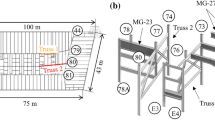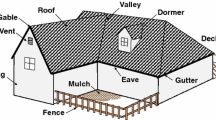Abstract
The National Institute of Standards and Technology (NIST) conducted an extensive investigation of the collapse of World Trade Center towers (WTC 1 and WTC 2) and the WTC 7 building. This paper describes the reconstruction of impact damage to each of the WTC buildings, as well as analytical studies related to the WTC building collapses. In addition, data and evidence that were collected, tests of the floor truss systems in the WTC towers that were conducted, the overall structural analysis approach, and the development of the collapse hypotheses are discussed to provide a basis for the impact analyses and the fire and structural response analyses in a companion paper. Three companion papers address the primary structural systems of the WTC towers and WTC 7, the effects of fire on the three buildings, and how these events contributed to building collapse. The papers provide an overview of the complex and extensive investigations undertaken by NIST at a level of detail that has scientific merit but presents key aspects from the voluminous official reports at a level suitable for the technical literature. The aircraft impact damage to structural members and their passive fire protection in WTC 1 and 2 were estimated through detailed aircraft impact simulations. The impact damage to WTC 7 was estimated from photographs after the collapse of WTC 1, where falling debris damaged the southwest corner of WTC 7. Based on the aircraft impact simulation, over half of the exterior columns on the north face of WTC 1 were severed and approximately 20% of the core columns were severed or heavily damaged. Spray-applied fire resistive material (SFRM) was dislodged by direct debris impact over five floors (Floors 94 to 98). WTC 2 structural damage was concentrated on the east side of the building. Over half of the exterior columns on the south face were severed and approximately 25% of the core columns were severed or heavily damaged. SFRM was dislodged by direct debris impact over six floors (Floors 78 to 83). WTC 7 was structurally damaged by debris from the collapse of WTC 1. Photographic evidence showed that seven exterior columns were severed near the southwest corner at the lower floors. Unlike the towers, the SFRM in WTC 7 likely remained intact except for local areas around the debris impact damage at the southwest corner. All three buildings were stable with the impact damage, but the WTC 2 building section above the aircraft impact damage leaned to the east and south.












Similar content being viewed by others
Notes
This is a publication of the National Institute of Standards and Technology (NIS) and is not subject to copyright in the United States. NIS0054 is a nonregulatory agency of the U.S. Department of Commerce. The purpose of NIST investigations was to improve the safety and structural integrity of buildings in the United States. NIST does not have the statutory authority to make findings of fault nor negligence by individuals or organizations. By law, no part of any report resulting from a NIST investigation into a building failure or from an investigation under the National Construction Safety Team Act may be used in any suit or action for damages arising out of any matter mentioned in such reports.
References
McAllister TP, Sadek F, Gross JL, Averill JD, Gann RG (2012) Overview of the structural design of World Trade Center 1, 2, and 7 buildings. Fire Technol. doi:10.1007/s10694-012-0285-6
Gann RG, Hamins A, McGrattan K, Nelson HE, Ohlemiller TJ, Prasad KR, Pitts WM (2012) Reconstruction of the fires and thermal environment in World Trade Center Buildings 1, 2, and 7. Fire Technol. doi:10.1007/s10694-012-0288-3
McAllister TP, Gross JL, Sadek F, Kirkpatrick S, MacNeill RA, Zarghamee M, Erbay OO, Sarawit AT (2012) Structural response of World Trade Center Buildings 1, 2, and 7 to impact and fire damage. Fire Technol. doi:10.1007/s10694-012-0289-2
Gross J, Hervey F, Izydorek M, Mammoser J, Treadway J (2005) Federal building and fire safety investigation of the World Trade Center disaster: fire resistance tests of floor truss systems. NIST NCSTAR 1–6B. National Institute of Standards and Technology, Gaithersburg
British Steel (1999) The behaviour of multi-storey steel framed buildings in fire. British Steel Plc, Swinden Technology Centre, South Yorkshire
McAllister T (ed) (2002) World Trade Center building performance study: data collection, preliminary observations, and recommendations, FEMA 403. Federal Emergency Management Agency, Washington, DC
Routley JG, Jennings C, Chubb M (1991) High-rise office building fire: One Meridian Plaza, Philadelphia, Pennsylvania (February 23, 1991). United States Fire Administration, Emmitsburg
Nelson H (1989) An engineering view of the fire of May 4, 1988 in the first interstate bank building, Los Angeles, California. U. S. Department of Commerce, NISTIR 89-4061, March 1989
Routley G (1988) First interstate bank building fire, Los Angeles, California, May 4, 1988. Technical Report USFA-TR-022/May 1988, United States Fire Administration, Emmitsburg
Powers RW (1970) One New York Plaza Fire. The New York Board of Fire Underwriters, New York
Gross JL, McAllister T (2005) Federal building and fire safety investigation of the World Trade Center Disaster: structural fire response and probable collapse sequence of the World Trade Center Towers. NIST NCSTAR 1-6. National Institute of Standards and Technology, Gaithersburg
McAllister TP, Gann RG, Averill JD, Gross JL, Grosshandler WL, Lawson JR, McGrattan KB, Nelson HE, Pitts WM, Prasad KR, Sadek FH (2008) Federal building and fire safety investigation of the World Trade Center disaster: structural fire response and probable collapse sequence of World Trade Center Building 7. NIST NCSTAR 1-9. National Institute of Standards and Technology, Gaithersburg
ANSYS (2007) ANSYS Mechanical Release 11.0. ANSYS Inc., Canonsburg
Livermore (2007) LS-DYNA Keyword User’s Manual. Livermore Software Technology Corporation, Version 971
Computers & Structures, Inc (2002) SAP2000, linear and nonlinear static and dynamic analysis and design of three-dimensional structures basic analysis reference. Berkeley
Sadek F (2005) Federal building and fire safety investigation of the World Trade Center Disaster: baseline structural performance and aircraft impact damage analysis of the World Trade Center towers NIST NCSTAR 1-2. National Institute of Standards and Technology, Gaithersburg
Zdenek B, Zhou Y (2002) Why did the World Trade Center collapse? Simple analysis. J Eng Mech 128(1):2–6
Abboud N, Matthys L, Tennant D, Mould J, Levine H, King S, Ekwueme C, Jain A, Hart G (2003) Anatomy of a disaster: a structural investigation of the World Trade Center collapses. In: Proceedings of the third congress forensic engineering, San Diego, pp 360–370
Post N (2002a) Report ties WTC collapses to column failures, Engineering News Record. McGraw Hill Construction
Glanz J, Lipton E (2002) In data trove. A graphic look at towers’ fall. The New York Times
Post N (2002b) Study absolves twin tower trusses, fireproofing. Engineering News Record, McGraw Hill Construction
Quintiere JG, di Marzio M, Becker R (2002) A suggested cause of the fire-induced collapse of the World Trade Towers. Fire Saf J 37(7):707–716
Usmani AS, Chung YC, Torero JL (2003) How did the WTC towers collapse: a new theory. Fire Saf J 38(6):501–533
Usmani AS (2005) Stability of the World Trade Center Twin towers structural frame in multiple floor fires. J Eng Mech 131(6):654–657
Lane B (2005) Comments on structural fire response and collapse analysis. Presentation given at the technical conference on the federal building and fire safety investigation of the World Trade Center (WTC) disaster. National Institute of Standards and Technology (NIST), Gaithersburg. http://www.nist.gov/el/disasterstudies/wtc/
Hamins A, Maranghides A, McGrattan KB, Ohlemiller TJ, Anleitner R (2005) Federal building and fire safety investigation of the World Trade Center disaster: experiments and modeling of multiple workstations burning in a compartment. NIST NCSTAR 1-5E. National Institute of Standards and Technology, Gaithersburg
Carino NJ, Starnes MA, Gross JL, Yang JC, Kukuck S, Prasad KR, Bukowski RW (2005) Federal building and fire safety investigation of the World Trade Center disaster: passive fire protection. NIST NCSTAR 1-6A. National Institute of Standards and Technology, Gaithersburg
Kirkpatrick SW, Bocchieri RT, Sadek F, MacNeill RA, Holmes S, Peterson BD, Cilke RW, Navarro C (2005) Federal building and fire safety investigation of the World Trade Center Disaster: analysis of aircraft impacts into the World Trade Center towers, NIST NCSTAR 1-2B. Gaithersburg
Irfanoglu A, Hoffmann CM (2008) Engineering perspective of the collapse of WTC-I. J Perform Constr Facil 22(62):1
Author information
Authors and Affiliations
Corresponding author
Rights and permissions
About this article
Cite this article
McAllister, T.P., Sadek, F., Gross, J.L. et al. Structural Analysis of Impact Damage to World Trade Center Buildings 1, 2, and 7. Fire Technol 49, 615–642 (2013). https://doi.org/10.1007/s10694-012-0286-5
Received:
Accepted:
Published:
Issue Date:
DOI: https://doi.org/10.1007/s10694-012-0286-5




